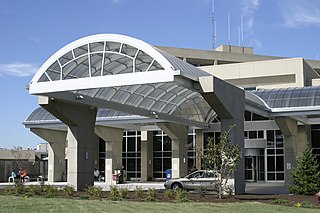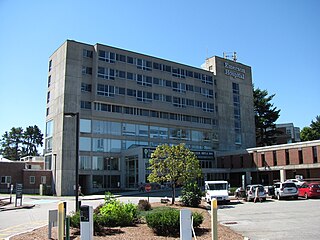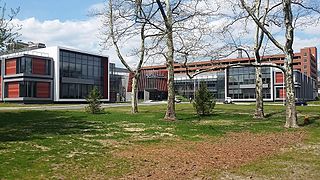
Beth Israel Deaconess Medical Center (BIDMC) in Boston, Massachusetts is a teaching hospital of Harvard Medical School and one of the founding members of Beth Israel Lahey Health. It was formed out of the 1996 merger of Beth Israel Hospital and New England Deaconess Hospital. Among independent teaching hospitals, Beth Israel Deaconess Medical Center has ranked in the top three recipients of biomedical research funding from the National Institutes of Health. Research funding totals nearly $200 million annually. BIDMC researchers run more than 850 active sponsored projects and 200 clinical trials. The Harvard-Thorndike General Clinical Research Center, the oldest clinical research laboratory in the United States, has been located on this site since 1973.

The South Texas Medical Center (STMC) or Bexar County Hospital District consists of 900 acres (360 ha) of medical-related facilities on the northwest side of San Antonio, Texas, United States.

UC Davis Medical Center (UCDMC) is part of UC Davis Health and a major academic health center located in Sacramento, California. It is owned and operated by the University of California as part of its University of California, Davis campus. The medical center sits on a 142-acre (57 ha) campus (often referred to as the Sacramento Campus to distinguish it from the main campus in nearby Davis) located between the Elmhurst, Tahoe Park, and Oak Park residential neighborhoods. The site incorporates the land and some of the buildings of the former Sacramento Medical Center (which was acquired from the County of Sacramento in 1973) as well as much of the land (and two buildings) previously occupied by the California State Fair until its 1967 move to a new location.

Cincinnati Children's Hospital Medical Center (CCHMC) is an academic pediatric acute care children's hospital located in the Pill Hill neighborhood of Cincinnati, Ohio. The hospital has 652 pediatric beds and is affiliated with the University of Cincinnati Academic Health Center. The hospital provides comprehensive pediatric specialties and subspecialties to pediatric patients aged 0–21 throughout southern Ohio and northern Kentucky, as well as patients from around the United States and the world. Cincinnati Children's Hospital Medical Center also treats adults, including adults with congenital heart disease and young adults with blood disease or cancer. Cincinnati Children's Hospital Medical Center also features a Level 1 Pediatric Trauma Center, 1 of 4 in the state. Cincinnati Children's is home to a large neonatology department that oversees newborn nurseries at local hospitals around Ohio. The hospital features an AAP verified 89-bed Level IV (highest possible) Newborn Intensive Care Unit.

TriHealth Good Samaritan Hospital is the oldest and largest private teaching and specialty health care facility in Cincinnati, Ohio. It opened in 1852 under the sponsorship of the Sisters of Charity. The hospital is member of TriHealth, a joint operating agreement between Catholic Health Initiatives and Bethesda, Inc. Cincinnati to manage Good Samaritan.

TriHealth Bethesda North Hospital is an acute, tertiary, teaching hospital in Montgomery, Ohio, United States that provides a wide range of services to individuals and families throughout the northeast corridor of Cincinnati and into Butler, Clinton and Warren counties. Founded in 1970 as a community satellite facility, Bethesda North is now the fourth largest hospital in Greater Cincinnati. The non-profit hospital is member of TriHealth, a community partnership between Bethesda and Good Samaritan Hospital.

Emerson Hospital is a hospital located in Concord, Massachusetts, at 133 Old Road to Nine Acre Corner, founded in 1911 on 40 acres (16 ha) donated by Charles Emerson, a nephew of Ralph Waldo Emerson. It is a full-service, non-profit community hospital and acute care medical center with 177 beds, providing advanced medical services to over 300,000 individuals in 25 towns.

Walter Reed National Military Medical Center is a United States military medical center located in Bethesda, Maryland. It is one of the largest and most prominent military medical centers in the United States, and it has provided medical care for several United States presidents since its opening in 1940.

Advocate Lutheran General Hospital (ALGH) is a 645-bed non-profit teaching hospital located in the Chicago suburb of Park Ridge, Illinois. Founded in 1897, Advocate Lutheran General Hospital is the sixth largest hospital in the Chicago area, and it operates a Level I trauma center. It also is home to Advocate Children's Hospital – Park Ridge, the only children's hospital in the greater north and northwest suburban region of Chicago. The hospital is a part of Advocate Aurora Health.

Edward Hospital is a healthcare provider located in southwest suburban Naperville, DuPage County, Illinois. The current President & Chief Executive Officer is Bill Kottmann, active since January 2017 replacing long-time President & CEO Pamela Meyer Davis who began her position in 1988.
Beaumont Health was Southeast Michigan’s largest health care system and was headquartered in Southfield, Michigan. It merged with Spectrum Health of West Michigan in 2023 to form Corewell Health, with the headquarters of the new health system being located in Grand Rapids. At the time of its merger, the health system had a net revenue of $4.7 billion and consisted of eight hospitals with 3,375 beds, 155 outpatient sites, nearly 5,000 physicians, more than 33,000 employees and about 2,000 volunteers. The flagship hospital of the system was the Beaumont Hospital, Royal Oak, located in the Detroit suburb of Royal Oak, Michigan.
Indiana University Health, formerly known as Clarian Health Partners, is a nonprofit healthcare system located in the U.S. state of Indiana. It is the largest and most comprehensive healthcare system in Indiana, with 16 hospitals under its IU Health brand and almost 36,000 employees. It has a partnership with the Indiana University School of Medicine (IUSM). The IU Health system has a total capacity of 2,696 beds.
CoxHealth is a six-hospital, 1,050 bed not-for-profit healthcare system headquartered in Springfield, Missouri. It serves a 25 county region of Southwest Missouri and Northwest Arkansas. CoxHealth is Springfield's largest employer, and the 7th largest non-governmental employer in the state of Missouri with more than 12,605 people employed throughout the system.
Sutter Medical Center, Sacramento (SMCS) is a medical center in Sacramento, California, that has been named one of the Top 100 Hospitals in the US for five years, including 2013–2015. It is owned and operated by Sutter Health, a Northern California not-for-profit health system. The center offers both community-based and tertiary medical services. In 2015, the center consolidated its Sutter Memorial Hospital campus in East Sacramento with its midtown Sutter General Hospital location, with the opening of the Anderson Lucchetti Women's and Children's Center and the complete remodeling of Sutter General Hospital into the Ose Adams Medical Pavilion. The midtown location is where Sutter Health's first hospital, Sutter Hospital, opened in 1923. The center also includes Sutter Center for Psychiatry, providing psychiatric, mental health and chemical dependency services since 1958.
TriHealth is a unified health system based in Cincinnati, Ohio, United States. It was originally formed in 1995. Currently the system comprises four general hospitals: Bethesda North, Good Samaritan, Bethesda Butler and McCullough-Hyde Memorial. In addition to these four hospitals TriHealth operates two regional free-standing emergency medical centers: Bethesda Arrow Springs and Good Samaritan Western Ridge. TriHealth's non-hospital services include physician practice management, fitness centers, occupational health centers, home health and hospice care. TriHealth is one of the largest employers in greater Cincinnati with over 13,000 employees.
Pill Hill is an informal name for a neighborhood in uptown Cincinnati, Ohio. It is one of the city's major employment centers, with a large concentration of hospitals and other medical facilities.

Banner - University Medical Center Phoenix is a 746-bed non-profit, acute care teaching hospital located in Phoenix, Arizona, providing tertiary care and healthcare services to the Arizona region and surrounding states. Banner - University Medical Center Phoenix is a hospital of the Banner Health System and is one of the flagship facilities of the system. The hospital is affiliated with the University of Arizona Colleges of Medicine in Phoenix and Tucson. The hospital is an American College of Surgeons verified Level 1 Trauma Center and has a rooftop helipad to transport critically ill patients from within the region.

Zucker Hillside Hospital is a psychiatric facility in Glen Oaks, Queens, New York. It opened in 1926, relocated to its present address in 1941, and was renamed in 1999 to its present name.













